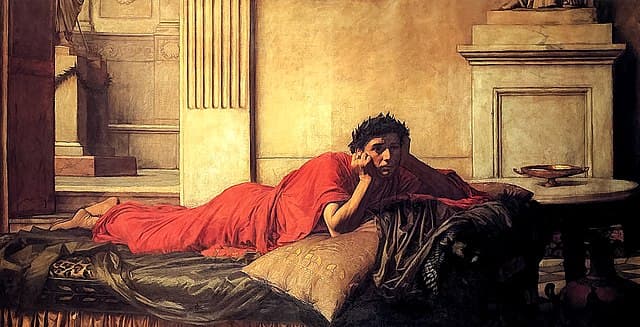This ‘Nero’ Is a Very Modern Monster
The new biography from Anthony Everitt and Roddy Ashworth renders an engaging account of the last Julio-Claudian, but in the process shines the lamp on our own disturbing fixations.

“Nero,” by Anthony Everitt and Roddy Ashworth. Random House, 448 pages.
Edward Gibbon begins “The Decline and Fall of the Roman Empire” with a splendid panorama of the Antonine dynasty’s holdings, reckoning up in brief the extent of their territories, the disposition of the legions and navies, and the prevailing conditions in religion and public life; the modern reader sees clearly that his Rome, under “the moderate system recommended by the wisdom of Augustus,” was a mirror for the British Empire of his own day.
Popular history often illuminates more about our own times than about the past — and the more distant the subject’s time, place, and circumstance, the more the light falls on our own faces. There are 19 centuries between us and Nero, the Roman emperor; the new biography from Anthony Everitt and Roddy Ashworth, “Nero,” renders an engaging account of the last Julio-Claudian, but in the process shines the lamp on our own disturbing fixations.
Messrs. Everitt and Ashworth take as their point of departure the fact that Nero, whose name, thanks largely to the tender attentions of the Christian tradition, is now a synonym for depravity, was in his own time enormously popular in certain sectors of Roman society. His grave was adorned with flowers for years after his death, and messianic associations clung to his memory in the empire’s Greek east. “The monster was loved,” they write.
What follows is a lively narrative, drawn primarily from classical sources with occasional resort to modern scholarship. Nero’s emergence from the bloody back-and-forth between the two branches of the imperial dynasty as the sole viable pretender is traced mostly through the works of Tacitus, Suetonius, and Cassius Dio. Questionably, but perhaps predictably, the authors prefer the sensational Suetonius, who “does not moralize,” to Tacitus.
“Nero” is a rehabilitative operation. Messrs. Everitt and Ashworth laud Nero’s rule by camarilla as effective, rather than a sign of weakness; likewise his concession of Armenia. They are adamant in their defense of Nero from Tacitus’ report that the emperor perpetrated a persecution of Christians following the city-destroying fire of 64, arguing that the passage in question is an interpolation by a Christian polemicist of the fourth century.
Although the argument is plausible, the debate is not settled, and certain elements are less than persuasive — the authors point to the “schoolboy error” in which the text of Tacitus refers to Pontius Pilate as a “procurator,” but the historian’s lack of precision with titles has been well established in Ronald Syme’s magisterial study, “Tacitus.” One suspects polemics motivate the verdict: “Nero was smeared for a crime he never committed, and the Roman Catholic Church still mourns the nonexistent martyrs of the Great Fire.”
The book’s arguments are occasionally self-contradictory. “He was quite a good singer and musician. The secret of Nero’s personality lay in his commitment to art. He was no dilettante and took music and drama extremely seriously. Audiences loved him. He was the prototype of a pop star,” the authors argue. A page later, they write, “Had he lived today he might have scraped a living as a mediocre rock musician.” Well, which is it: quite good, or mediocre?
Even as they kick against historical consensus, Messrs. Everitt and Ashworth assume little. Plato is referred to as “the great Athenian thinker Plato”; Rome’s republican constitution and the outcome of her civil wars are summarized swiftly. This seems to be a regrettable admission that a popular audience cannot be expected to be familiar with historical rudiments; while these asides are perhaps necessary, and are clearly written, they slow the book’s momentum.
The question: Why do we need a sympathetic partial rehabilitation of Nero for the general public? Why is there an appetite for a book arguing that the little horn of John’s Beast wasn’t so bad — that a man who reportedly slept with and then muredered his mother, a claim that Messrs. Everitt and Ashworth credit, who drained the public coffers, who had a slave boy castrated for his own delectation, was just a celebrity out of his time, a misled “rock star”?
“Nero” is an easy read, and picks a steady narrative out of the ancient sources. It is fresh and accessible and salacious; its historiographic faults are not crippling. Yet we wonder what it says about the modern audience that our histories are justifications of vice and celebrations of private lusts.

